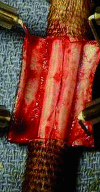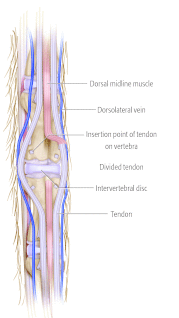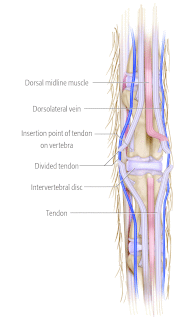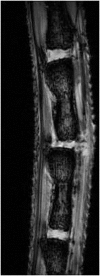Biological intervertebral disc replacement: an in vivo model and comparison of two surgical techniques to approach the rat caudal disc
- PMID: 22956934
- PMCID: PMC3427968
- DOI: 10.1055/s-0030-1267084
Biological intervertebral disc replacement: an in vivo model and comparison of two surgical techniques to approach the rat caudal disc
Abstract
Study design: Prospective randomized animal study.
Objective: To determine a surgical technique for reproducible and functional intervertebral disc replacement in an orthotopic animal model.
Methods: The caudal 3/4 intervertebral disc (IVD) of the rat tail was approached by two surgical techniques: blunt dissection, stripping and retracting (Technique 1) or incising and repairing (Technique 2) the dorsal longitudinal tendons. The intervertebral disc was dissected and removed, and then either discarded or reinserted. Outcome measures were perioperative complications, spontaneous tail movement, 7T MRI (T1- and T2-sequences for measurement of disc space height (DSH) and disc hydration). Microcomputed tomographic imaging (micro CT) was additionally performed postmortem.
Results: No vascular injuries occurred and no systemic or local infections were observed over the course of 1 month. Tail movements were maintained. With tendon retraction (Technique 1) gross loss of DSH occurred with both discectomy and reinsertion. Tendon division (Technique 2) maintained DSH with IVD reinsertion but not without. The DSH was demonstrated on MRI measurement. A new scoring system to assess IVD appearances was described.
Conclusions: The rat tail model, with a tendon dividing surgical technique, can function as an orthotopic animal model for IVD research. Mechanical stimulation is maintained by preserved tail movements. 7T MRI is a feasible modality for longitudinal monitoring for the rat caudal disc.
Figures










Similar articles
-
Establishment of intervertebral disc degeneration model induced by ischemic sub-endplate in rat tail.Spine J. 2015 May 1;15(5):1050-9. doi: 10.1016/j.spinee.2015.01.026. Epub 2015 Jan 28. Spine J. 2015. PMID: 25637466
-
Expression of adiponectin receptors in human and rat intervertebral disc cells and changes in receptor expression during disc degeneration using a rat tail temporary static compression model.J Orthop Surg Res. 2016 Nov 22;11(1):147. doi: 10.1186/s13018-016-0481-z. J Orthop Surg Res. 2016. PMID: 27876065 Free PMC article.
-
Longitudinal characterization of intervertebral disc remodeling following acute annular injury in a rat model of degenerative disc disease.Connect Tissue Res. 2020 Nov;61(6):568-576. doi: 10.1080/03008207.2019.1635589. Epub 2019 Jul 5. Connect Tissue Res. 2020. PMID: 31232119
-
Role of biomechanics in intervertebral disc degeneration and regenerative therapies: what needs repairing in the disc and what are promising biomaterials for its repair?Spine J. 2013 Mar;13(3):243-62. doi: 10.1016/j.spinee.2012.12.002. Epub 2013 Jan 29. Spine J. 2013. PMID: 23369494 Free PMC article. Review.
-
Measurement of Three-Dimensional Internal Dynamic Strains in the Intervertebral Disc of the Lumbar Spine With Mechanical Loading and Golden-Angle Radial Sparse Parallel-Magnetic Resonance Imaging.J Magn Reson Imaging. 2021 Aug;54(2):486-496. doi: 10.1002/jmri.27591. Epub 2021 Mar 13. J Magn Reson Imaging. 2021. PMID: 33713520 Free PMC article. Review.
Cited by
-
Finite element modeling to predict the influence of anatomic variation and implant placement on performance of biological intervertebral disc implants.JOR Spine. 2023 Dec 27;6(4):e1307. doi: 10.1002/jsp2.1307. eCollection 2023 Dec. JOR Spine. 2023. PMID: 38156058 Free PMC article.
-
Total disc replacement using tissue-engineered intervertebral discs in the canine cervical spine.PLoS One. 2017 Oct 20;12(10):e0185716. doi: 10.1371/journal.pone.0185716. eCollection 2017. PLoS One. 2017. PMID: 29053719 Free PMC article.
-
Translation of an engineered nanofibrous disc-like angle-ply structure for intervertebral disc replacement in a small animal model.Acta Biomater. 2014 Jun;10(6):2473-81. doi: 10.1016/j.actbio.2014.02.024. Epub 2014 Feb 20. Acta Biomater. 2014. PMID: 24560621 Free PMC article.
References
-
- Mizuno H, Roy A K, Zaporojan V. et al.Biomechanical and biochemical characterization of composite tissue-engineered intervertebral discs. Biomaterials. 2006;27(3):362–370. - PubMed
-
- Zhang H, La Marca F, Hollister S. et al.Developing consistently reproducible intervertebral disc degeneration at rat caudal spine by using needle puncture. J Neurosurg Spine. 2009;10:522–530. - PubMed
LinkOut - more resources
Full Text Sources
Other Literature Sources

